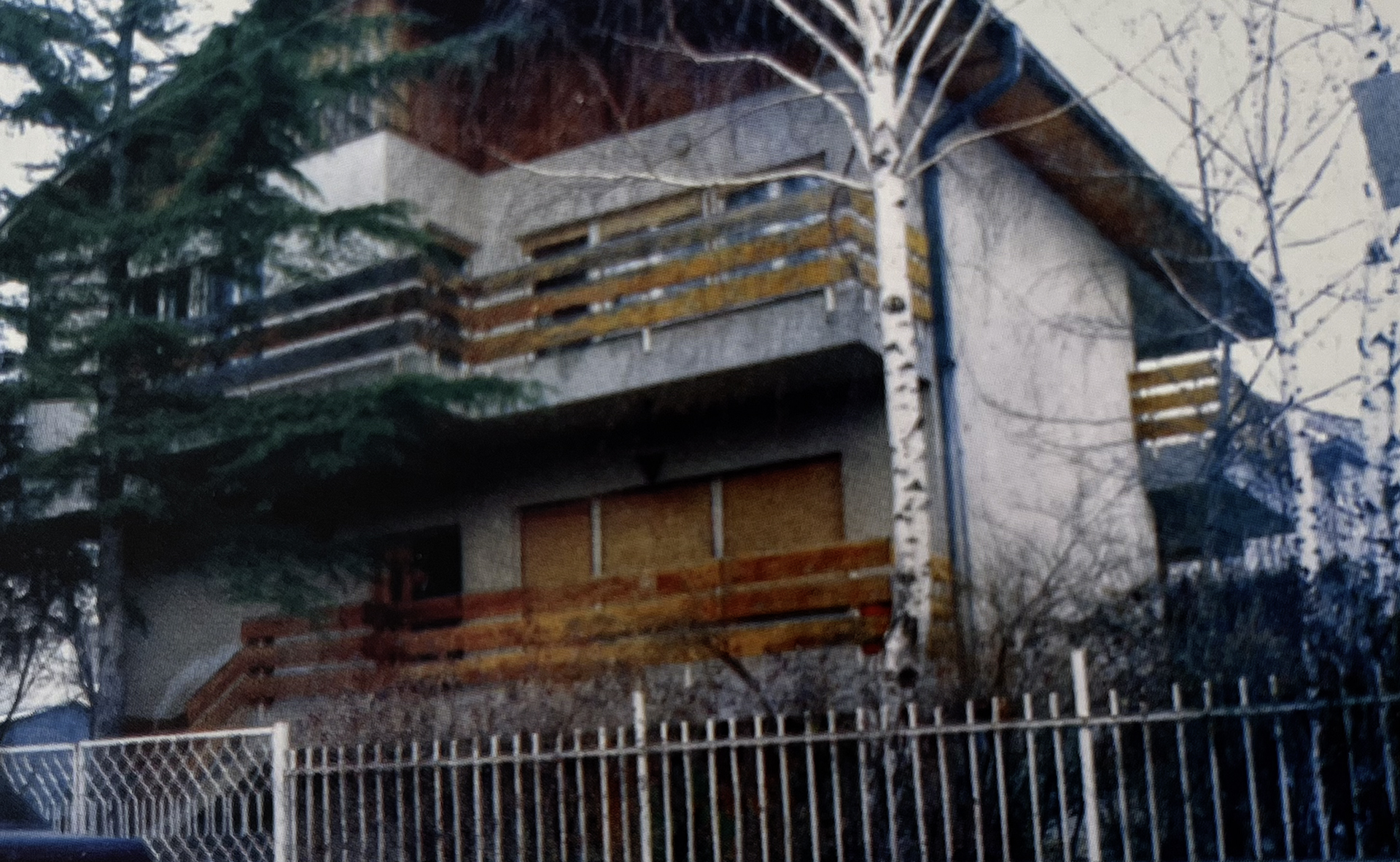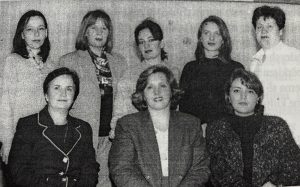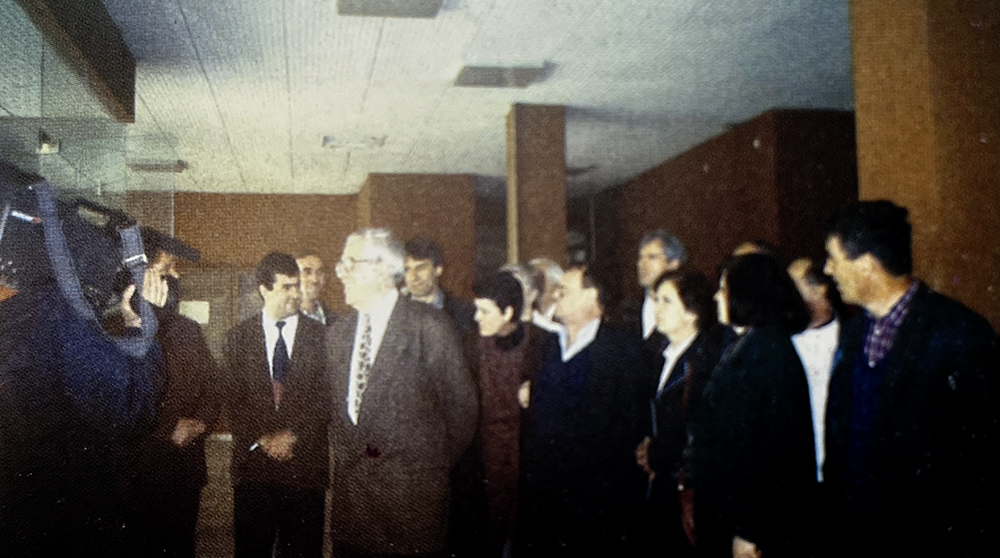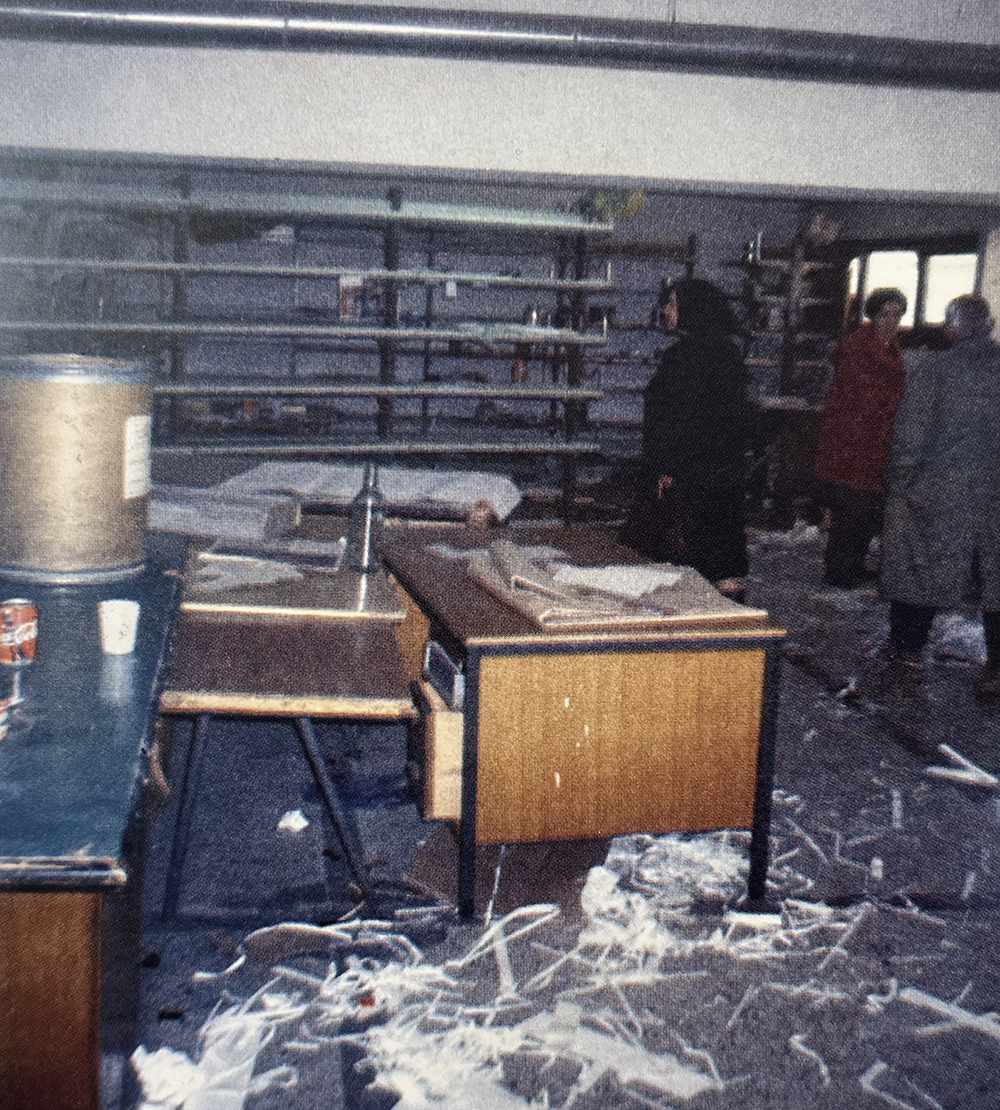As she accompanies me inside the iconic modernist building designed by architect Miodrag Pecić, the Internal Scientific Archive of the Albanological Institute’s archivist Trashe Prelvukaj, said: “It’s so quiet here.”
In 1977, the Institute of Albanology moved to the angular white-walled building next to the University of Prishtina campus. It was first established on June 1, 1953 following the founding of similar institutes throughout the Socialist Federal Republic of Yugoslavia.
Prelvukaj was hired in 1979, just two years after the Institute moved from a one-story building to the new facility. The building was carefully designed to accommodate the needs of researchers covering five fields of study — linguistics, literature, folklore, history and ethnology.
As an institution founded to facilitate Albanian studies, it inevitably became the target of attacks on the cultivation of Albanian culture and identity within the former Yugoslavia.
The calmness that Prelvukaj mentioned as characteristic of the Institution’s work, has consistently faced disruptions since the Institution’s establishment seven decades ago. The Institute’s existence and future were called into question amid successive crises in the former Yugoslavia and later after the establishment of the United Nations Mission in Kosovo (UNMIK).
Among all this, there is something fascinating in the personal experiences of those who work behind these walls, whose stories are often overlooked and taken for granted. Nuances in personal stories and experiences are hidden within overarching narratives. These people experienced the enthusiasm of establishing this institution, the anxiety and youthful desire to be part of it and the fear when their work became dangerous. They also experienced a mixture of hope and disappointment when the existence of their workplace was called into question after the 1999 war in Kosovo.
On June 1, 2023 the Albanological Institute marked its 70th anniversary. In commemoration of the anniversary, some of the employees, all from different backgrounds and generations, warmly walked me through the story of their workplace.
Struggling with uncertainty
Established for the first time in 1953, the Institute’s first home was a one-story building in Prishtina, next to today’s National Library. However, the Institute closed in 1955, before it had even started work properly.
This closure occurred at the time of forcible arms collections by the Yugoslav government, resulting in the further suppression of Kosovar Albanians’ freedoms. The Institute remained closed until 1967. It was then re-established following the departure of Aleksandar Ranković from the leadership of the Yugoslav secret service and police force. This re-establishment occurred during the wave of efforts by Kosovar Albanians to use new political-social momentum to articulate demands for autonomy, the right to use the Albanian language and to education.
At that time, Zymer Neziri, who until his retirement worked as a researcher in the Department of Folklore at the Institute, was in his first year of studies at the Department of Albanian Language and Literature at the Higher Pedagogical School in Prizren. He dreamed of working at the Albanological Institute of Prishtina. Amid the harsh stories about the turbulent political situation of the time, Neziri, with a smile that momentarily transports him to another era, shares a memory from when he first joined the Institute as an assistant at the Department of Folklore. At the time, this department was led by folklorist and professor Anton Çetta.
“They were all old one-story buildings, built at the time when there was a military camp here [at today’s university campus],” Neziri began. Because he had studied at the Higher Pedagogical School in Prizren and not in Prishtina, he said that no one knew or remembered him as a student. “After a while of working here [at the Institute], my professor and colleague, Idriz Ajeti, came and knocked on my door, he said, ‘Where is Anton?’ I said: ‘He’s gone out for coffee.’ He closed the door, went away, came back a little later and said: ‘Wait, what are you doing here?’ I had already been working as an assistant there for a year,” recalled Neziri.
His fond recollections of the workplace ended rather quickly. In 1973, just two years after starting the job he had once dreamed of, Neziri was fired due to his involvement in the student protests of 1968. These protests demanded the establishment of a university and a constitution for Kosovar Albanians in Yugoslavia. He only returned to work at the Institute in 1992, two decades later.
Kosovo’s autonomy as a province in Yugoslavia, guaranteed by the 1974 constitution, was abolished in 1989. As the wars preceding the breakup of Yugoslavia began in Slovenia, Croatia and Bosnia and Herzegovina, campaigns for expulsion and the exclusion of Albanians in Kosovo escalated under the leadership of Slobodan Milošević. After more than a year of being denied participation in public life — education, health, culture — the Albanian population started to use private spaces, in what is known as the parallel system.
Neither the Albanological Institute nor its workers could escape eviction from the building. In 1994, it became among the last institutions to be excluded from public life. Archivist Prelvukaj enthusiastically describes the warm work environment at the Institute and how, as the youngest employee, every working day was filled with excitement and positivity, but changes her tone as the bitter memory of 1994 crosses her mind. “They took the Institute from us. They beat and mistreated us all, they forced us to leave while shouting: ‘Get out!'” she said.
Current Head of the Folklore Department Arbnora Dushi has similar thoughts about that period. She said that even though they had hoped not to be fired, the Institute’s employees were prepared for the worst. In preparation for this, the Institute’s entire archive was moved to the homes of employees and other volunteers.
“At night the workers of the Institute moved the books using carts,” said Dushi, repeating the memories of her older colleagues.
So, from 1994 to 1998, the Institute operated in Dr. Musa Haxhiu’s two-story house in the Sunny Hill neighborhood. Dushi described this house as large for a private house, but small for the Albanological Institute.

The Albanological Institute was housed in Musa Haxhiu’s private house between 1994 and 1998. Credits: Archive of the Albanological Institute.
At that time, 24-year-old Dushi started working at the Institute. Together with the political and social upheavals, new generations arised who dreamed of working at the Institute. She remembers her first day at the Institute on January 1, 1997. “The joy was great, you have no idea. I have rarely felt the joy I experienced on that day, because it was a great achievement to work at the Institute. All the students of literature and language idealized it from outside,” she said.
Aware of everything that was happening, Dushi and her peers nevertheless found room for enthusiasm. “I remember that [the salary] was, as I recall, 40 marks at first, collected from the three percent fund in ’96. But who thought about their salary back then? All that mattered was to work for the institute. No one thought about their salary … Back then, we all were poor. Our parents were jobless, they had all been forced out from their jobs,” Dushi recalled. The Albanians of Kosovo, excluded from public life, started to maintain their parallel lives in private spaces through what is known as the three percent fund. Citizens of Kosovo and the diaspora poured contributions into this fund to ensure minimal financial compensation for workers who continued their work in private spaces, especially those in the health and education sectors.
Performing public life in private spaces was not something new for Dushi’s generation, which completed higher education under similar circumstances. “We were the generation that faced this form of violence from the very beginning and we resisted, which encouraged us to learn even more, to become good students and not to stop studying. In ’91 we were kicked out of the faculty building. Then, I continued my studies in private facilities in Vranjevc and wherever people offered private houses. We had great enthusiasm and a desire to work,” she said.
Dushi belongs to the generation of scholars who joined the Albanological Institute in the 1990s — the first group of scholars to join since the founding generation in the 1950s.

The young generations of researchers always dreamed of working at the Institute. In the photo: Employees of the Institute. First from the left, standing: Arbnora Dushi. Third from the left, standing: Trashe Prelvukaj. Photo: Archive of the Albanological Institute.
Among this group of nine researchers was also the current director of the Albanological Institute, Hysen Matoshi. Matoshi recalls the enthusiasm and joy for starting work at the Institute and the unusual working conditions of that time.
“Accessing this institution happened under very specific circumstances, in an inadequate working environment with very difficult working conditions. On the other hand, these difficulties resulted in something very interesting for me and I believe for my generation in general because we found a warmth, a closeness with our colleagues who were already well-known Albanology researchers. They welcomed us, helped us and showed us how to work on research projects,” said Matoshi.
Matoshi remembers how the Institute’s work was organized in the 40-square-meter living room in the small house where the Institute was located at the time. When there were more people that could fit in the living room of Musa Haxhiu’s house, other people offered alternative spaces.
Despite all the Institute’s employees’ efforts and a desire to imitate a normal life in abnormal circumstances, research almost ground to a halt in those years. Field work was severely affected during this time, partly due to lack of funds but primarily due to police repression.
“For example, archaeologists would go out to dig somewhere and the police would come and ask if they had permission, ‘why are you digging?’ ‘what are you doing there?’ It was also difficult to secure literature since the Institute’s library was not operational,” said Matoshi.
As she walks through her memories of the 1990s, archivist Prelvukaj emphasizes the stories that center on her precious relationship with archival material and its preservation. This defined her work for a long time.
“When I came [in 1979] I found it completely ready, with an archive that had been moved there by Anton Çetta, When I came, Anton Çetta was here [part of the archive], and I used to work with him until late at night, until I got familiar with the departments,” Prelvukaj said, adding that “currently, the archive is not operational. During the war, they didn’t touch the library at all, they just took the entire archive from us.”
The Albanological Institute’s archive, consisting of documents, folkloric, ethnographic, ethnomusicological materials as well as cameras, film tapes, and other auxiliary equipment for field research, was irreparably damaged.
Throughout the history of openings and closings, the Institute’s archival material was mainly collected through field research and a portion of material was collected in the 1950s. During this period, the initial staff asked members of the public and researchers, through the Rilindja newspaper, to submit material in their possession to enrich the Institute’s Internal Scientific Archive.
On April 1, 1998, when the employees returned to the current facility, some of the archival material that had been preserved in private homes was returned. This was a result of an agreement for the return of Albanians who had been excluded from educational facilities, signed in September 1996 by then-president of Kosovo Ibrahim Rugova and then-president of Serbia Milošević, mediated by the Catholic Saint Egidio Community.

Workers of the Albanological Institute took the Institute’s archive to private homes for preservation, before the institute’s closure in 1994. Credits: Archive of the Albanological Institute.
This moment is crystal clear in Matoshi’s memory. “We returned the materials in 1998, because people’s houses were full. There were people who had half their house filled with books and couldn’t even use the space in their own house,” he said. This return was quickly met with a new expulsion.
After Matoshi and his colleagues returned the archival material, organized it and made the archive operational, Serbian armed forces forcibly expelled them from their workplace in 1999.
The archive, which had been collected under extremely restrictive circumstances, never returned to its former state. The importance of time in Albanian studies, particularly in the field of folklore, cannot be overstated. This is because a significant portion of the material is gathered through recordings of traditions and stories that have been passed down through generations.
As time passed, many of those who remembered this precious material passed away. In an attempt to explain the impact that lost time and historical and political turmoil had on their work, Neziri mentions the challenge of collecting traditional songs from Drenica.
“Now [after the war] when I did the last research in Drenica, only 12 songs were found. Out of 104 villages in Drenica, only 12 songs. This cannot be true, but only 12 have been collected. Because back then, dealing with folk songs was scary, it was a problem,” he said. The collection of folklore material often depends primarily on the people who know the verses by heart and interpret them for researchers who then document them through recording.
The focus of the Albanological Institute’s employees shifted toward survival rather than research endeavors. They were very aware of the challenge of resurrecting an institution that had never been given the chance to establish itself properly.
The return that was cut short
The return to the workplace in April 1998 was a period characterized by efforts to recover lost time and establish a semblance of ordinary life. However, it would later prove to be far from normality.
The return was also the first time that Matoshi and Dushi entered the facility as employees, since they spent their first year of work in Haxhiu’s house. That day, Dushi remembers a moment of collective joy that finally, the oppression was beginning to fade. “Everyone was on the street, applauding. It was seen as a source of relief in response to the prevalent violence and repression at that time,” said Dushi.
Besides their presence at the facility’s opening, members of the public were also involved in turning the Institute into a more suitable place for work. “We managed somehow, many people brought chairs and equipment. Some help to paint and brighten the walls a little, to fix it up a little. … There was an extraordinary support for the institute in that period, a great will was shown. Then they came to help us clean and fix the building. During that period we used it,” said Matoshi, recalling the solidarity of that time.

In 1998, the Institute returned to work after a four-year shutdown. The opening was met with collective enthusiasm. Credits: Archive of the Albanological Institute.
However, this enthusiasm for the return was met with a difficult situation in Kosovo. “We tried to return, even though the situation in Kosovo was getting worse day by day. We came to work, we heard the shelling around Prishtina, we heard stories, claims, events, news, panic, it became daily,” Dushi said, remembering the years 1997 and 1998.
She continues her story, because even in those times, the Institute’s story continued. In a spirit of hope and determination, the researchers even attempted to go out in the field to do research.
“We tried to work in these circumstances. I remember we even organized a field trip. We contacted the folk singer Tahir Drenica, we tried to go undercover, there were 1,000 police checkpoints and we said ‘we’re going to meet a friend.’ We used to go and record his songs,” she said.
This was also cut short. By 1998, military aggression and the murder of Albanians had started in Kosovo’s villages, especially in Drenica. In February of that year, 24 Albanians were killed in Qirez and Likoshan, while physical violence became more frequent in the urban centers. The war, which many Albanians already began to see and feel, broke out even more in 1999. As a result, the Institute was shut down and significant damage was caused to its work. Even the portion of the archive that was saved during the successive openings and closings was destroyed.
Armed troops from the Yugoslav Army were aggressively positioned at the Institute, so the employees went to find other jobs in an attempt to survive. They waited patiently for freedom and for a new opening, which they hoped would not end with another closure.
After the war
Upon resuming work after the war, there was a sense of confidence that this might be the last time the Institute would have to start all over again. However, even this period was accompanied by uncertainty and threats to the Institute’s existence.
With the end of the war, Kosovo’s citizens found themselves caught between the enthusiasm for freedom and the challenge of building a state. When the war ended in 1999, Kosovo became a protectorate under UNMIK. Dushi remembers that UNMIK authorities advocated for the dissolution of the Institute and the project they included it in did not align with what the Institute’s employees had tried to build over the decades.
UNMIK treated Kosovo as a project. UNMIK achieved its goals through actions and decisions that had no sensitivity to the histories of the institutions it now managed or to the social context in which these institutions existed.
Dushi described the attempts to reconceive the Albanological Institute to accommodate the goals of the United Nations as uninformed and arbitrary.
“They said, ‘You are not a state now, before you had the right to have the Albanian Institute because it was the right of minorities, but now Albanians are not a minority in Kosovo, so now you don’t need such an institute. It will become an institute for all of Kosovo’s nationalities and minorities, which means you will remove the national entity and turn it into a state entity,” recalled Dushi.
In this context, Dushi said that a new need for resistance presented itself. According to her, UNMIK’s position was that Albananology is not a legitimate field of study and that the Institute should not be called the “Albanological Institute” anymore.
“Sadri [Fetiu, the then director of the Institute] did not agree and was resistant to this. And they said ‘we cannot finance you because we don’t finance uninational institutions,’ and then they cut off funding for three months, so we were left without any funding. This happened in the year 2000, and that was the time when things in Kosovo started to come back into operation,” said Dushi.

The premises of the Albanological Institute were severely damaged as a result of the 1999 war. Citizens, on a voluntary basis, helped to renovate it. Credits: Archive of the Albanological Institute.
From 2004, the Albanological Institute operated within the Ministry of Education, Science, Technology and Innovation (MESTI). It has received funds directly from the ministry’s budget since 2008, when Kosovo declared independence. Working within the ministry is generally not conducive to the Institute’s dynamic research and scientific work. Because there is no self-managed budget, researchers’ field work is often hostage to bureaucratic procedures and administrative approval.
Despite the Institute employees’ endeavors to push forward the regulation of their work through legislation that takes into account the specifics of their field, there is currently no dedicated law for the Albanological Institute. Instead, its operations are regulated by the Law on Scientific- Research Activities.
Meanwhile, despite all the difficulties that have defined the Institute’s story, it continues to be a dream workplace for many. Zana Hoxha, an independent scientific researcher at the Institute and former archaeologist, said that she joined with the belief that it is the ideal place to realize a researcher’s academic vision. “From the position I am in today, I understand why it is the dream of many students and researchers to be part of this institution,” she said.
However, according to Hoxha, due to the late establishment of educational and scientific institutions in Kosovo, Kosovar researchers are lagging behind in the field of Albanology. Researchers at the Institute’s five departments need to regularly review Albanological material because it is always changing. Due to lost time and the need for timely research, constant updating is crucial in order to keep up with the times.
According to Hoxha, a new approach is needed. “There are many unstudied materials, but there are also materials studied by others that are poorly interpreted. Albananology, in all sectors, should be studied and the Albanian identity should be studied in step with the times,” said Hoxha. According to her, the right way to approach both the existing and future material is through combining disciplines and different research methods possessed by the Institute’s researchers.
The contemporary relevance of Albanology, for many, may be debatable and the Institute may function in isolation. The Institute is tied to a part of Kosovar history that is not necessarily in conversation with today’s identity, questions and the dilemmas that new social contexts bring. Today’s society needs to face this context and provide solutions. I thought this too before embarking on this odyssey of meetings and conversations with the Institute’s employees.
Regarding this issue, Scientific Advisor at the Institute Arben Hoxha said that historical contexts are not amorphous entities and outside of human beings — they are made possible by people.
“In this sense, the Albanological materials and the methods of producing Albanological knowledge change. And, in order not to lose the meaning of its existence, Albanology must rethink itself within the new context of this millennium,” said Hoxha.
Hoxha sees a need for change when he contemplates the future. “Albanology, today, above all, requires a new conceptual framework for thinking about ourselves, in relation to interacting with others and the world, but also in the face of the attacks.”
At the 70th anniversary of its initial establishment, the Albanian Institute of Kosovo seems to not yet be in a position to rethink itself in relation to the context of a constantly changing society.
As the study material of Albanological Institute is completely subject to time — an important part of it is lost as time passes, while another part is constantly evolving — the Albanological Institute is stuck in a vicious and cyclical battle for survival, forcing it to put science, documentation and knowledge production second.
Feature Image: Atdhe Mulla, together with photographs from the personal archive of Trashe Prelvukaj and from the archive of the Albanological Institute / K2.0






